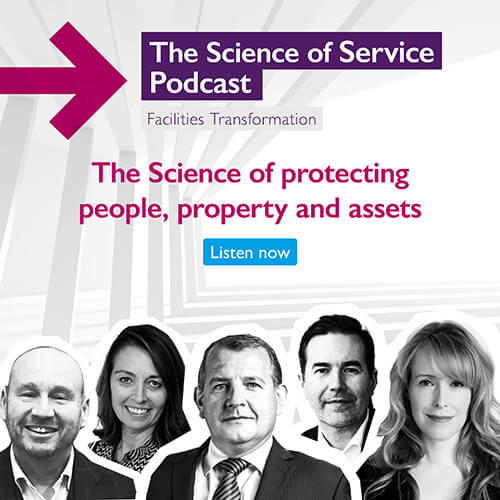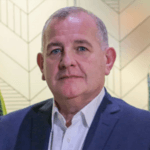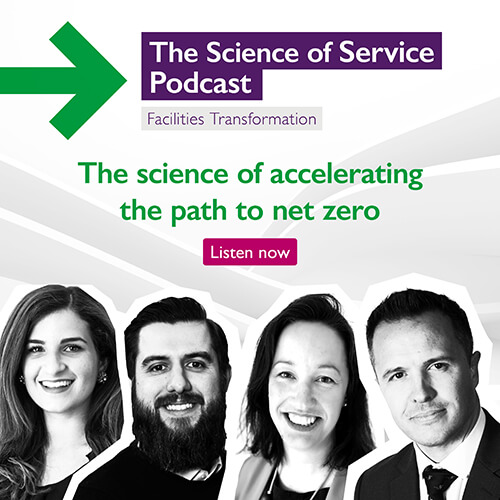The Science of Service Podcast: Beneath the tip of the security iceberg

By Ian Ellison, Workplace Geeks
Listen to episode three now: The science of protecting people, property and assets
What’s your reaction to the word ‘security’? Perhaps it triggers thoughts of guards outside shops and buildings. Or maybe the queue before you get to purchase duty free bargains in the airport. The truth is that these are just the commonly experienced tip of an interconnected security iceberg.
In fact, have you ever stopped to think what it really takes to keep our homes, buildings and organisations safe? And what about public services, towns and cities?
If you haven’t, try it now. Get a blank sheet of paper to map it out. Start in the middle, with the things you value the most – family, friends, home and car, for example. Now think about the different ways you, or others on your behalf, keep them secure. One thing is for sure – the detail and complexity of security in our lives is staggering.
A protective mindset
Which brings me to episode three of The Science of Service Podcast, hosted by the Workplace Geeks: Chris Moriarty and me, Ian Ellison. This time our focus is the tricky but essential business of protecting people, property and assets.
To set the scene, we turn first to an industry expert, namely Professor Alison Wakefield, Co-Director of the University of West London’s Cybersecurity and Criminology Centre. Alison thinks in terms of ‘protective security’, with physical, personnel, information and technical elements. This framework is also adopted by the UK, Australian and New Zealand governments and shows the scope of what must be taken into consideration when implementing an effective security strategy.
Securing cities in the sky
Protective security also sits at the forefront of Andy Donaldson’s mind as Head of Security for Real Estate Management UK Ltd. REM is responsible for a multi-billion pound property portfolio that includes iconic properties like The Shard in London. Andy describes it as a vertical, self-contained city in the sky. Not only is The Shard home to Mitie’s head office, but it also contains a multitude of business, healthcare, leisure and residential facilities. Chris is lucky enough to join Andy on a tour of The Shard, getting a firsthand glimpse into the secrets of the 95-storey building’s security.
Security transformation
We then turn to Mitie’s security experts. As a member of the Group Executive Leadership Team, Jason Towse is responsible for a broad range of services, including security; while Emma Shaw heads up the Intelligence Services team as Managing Director. Between them, they paint a rich picture of how Mitie is combining traditional security services with advanced intelligence and risk insights. A genuinely integrated security system requires careful consideration of threats to human, physical, digital and intangible assets, such as brand and reputation. And Mitie is leading the way.
Swimming pool-sized constraints
Imagine aviation grade security in a space the size of a swimming pool, with a constant throughput of customers and trains. This is the scenario facing Matt Rogers, Head of UK Security for Eurostar. Extreme constraints like this are often a driver for both product and service innovation. Once again Chris gets access all areas, joining Matt on a visit to the Eurostar hub to see how these unique challenges are tackled. Even with robust security checks in place, Mitie plays a crucial role in making sure the customer experience remains seamless. And we learn how risk and intelligence-based people, property and asset protection feature significantly in The Science of Service arsenal.
Delivering diversity
To round out the show, we return to Prof. Wakefield to consider employment opportunities within the profession. It’s well known that the increasing digital complexities of the FM sector require upskilled data science and tech capabilities. A refreshing upshot of this is the opportunity for more equality, diversity and inclusion in the security profession. And with a Mitie-backed partnership (through Linx International) to offer an MSc in International Security and Risk Management at the University of West London, both Alison and Mitie are walking the talk too. It’s another essential part of the modern security iceberg.

The Science of protecting people, property and assets
The world of security is evolving. The increasing severity, frequency and sophistication of threats need solutions advanced enough to cope with these new challenges.
Chris and Ian dive into the innovative world of protective security – and explore what it means for today’s biggest organisations. They get a glimpse behind the scenes of security at two of London’s most iconic spaces, learning the secrets of how The Shard and Eurostar’s St Pancras hub are kept safe. There’s a fine balance between robust measures and maintaining a seamless customer experience.
-
 Jason TowseManaging Director, Mitie Business Services
Jason TowseManaging Director, Mitie Business Services -
 Emma ShawManaging Director of Mitie Intelligence Services
Emma ShawManaging Director of Mitie Intelligence Services -
 Matt RogersHead of UK Security, Eurostar International
Matt RogersHead of UK Security, Eurostar International -
 Andrew DonaldsonHead of Security, Real Estate Management (UK)
Andrew DonaldsonHead of Security, Real Estate Management (UK) -
 Professor Alison WakefieldCo-Director Cybersecurity and Criminology Centre, University of West London
Professor Alison WakefieldCo-Director Cybersecurity and Criminology Centre, University of West London
The world of security is evolving. The increasing severity, frequency and sophistication of threats need solutions advanced enough to cope with these new challenges.
Chris and Ian dive into the innovative world of protective security – and explore what it means for today’s biggest organisations. They get a glimpse behind the scenes of security at two of London’s most iconic spaces, learning the secrets of how The Shard and Eurostar’s St Pancras hub are kept safe. There’s a fine balance between robust measures and maintaining a seamless customer experience.
“Security is often viewed as an end state. Security is about guards, it’s about locks, it’s about CCTV cameras. When its true form, ‘protective security’, is about the mitigation of risks stemming from those people who could wish us harm’.”
Andrew Donaldson, Head of Security Real Estate Management (UK) Ltd
Episode links
Mitie Security. Intelligence. Technology. People (video)
Case study: Bank of England – protecting the world’s 8th largest bank
Security & Fire Services | Facilities Management Provider | Mitie
Episode 3: The science of protecting people, property and assets
Speakers:
- Chris Moriarty
- Ian Ellison
- Professor Alison Wakefield
- Andy Donaldson
- Emma Shaw
- Jason Towse
- Matt Rogers
Ian Ellison: How secure do you feel right now? Just pause for a moment and reflect. Because many people, if they are lucky enough, take their own personal security for granted. Going about their day, popping into the office, picking up something from the shops, catching the train home; never really stopping to think about how safe they are at any given moment.
Meanwhile, an army of professionals carefully monitor, assess and manage our safety using a range of cutting-edge tools and technology so that we can go about our business blissfully unaware of any potential threats. But the truth is that many of those threats have, over time, become more sophisticated, more resilient and more determined in recent years.
Geopolitical tensions, political unrest and social activism are just three of the macro factors that can turn a mundane day into a national or even international news event. And they seem to be occupying our screens more frequently than ever. And this isn’t just about physical security. In the UK alone, it is estimated that over half a million cyberattacks are detected daily.
Whether it’s mischievous hackers, professional scammers, or nation states looking to disrupt operations, the security industry is faced with an increasingly complex landscape of threats that it needs to protect us from. But with the help of technology, they remain vigilant.
Connected devices, big data and artificial intelligence, all combined with decades of experience, are transforming the security sector into one that not only is able to respond to incidents when they occur, but can also predict and neutralise threats before they’ve had a chance to cause their intended harm.
This is the story of that technology-enabled workforce. This is The Science of Service.
Chris Moriarty: Hello and welcome to episode three of The Science of Service Podcast brought to you by Mitie. I’m Chris Moriarty…
Ian Ellison: And I’m Ian Ellison.
Chris Moriarty: So quick recap. We’ve been sent on a voyage of discovery by Mitie CEO, Phil Bentley, who challenged us to go and find out more about how organisations, Mitie clients, are using the very latest technology to transform their facilities.
Now, we’ve already looked at climate change, so go back and have a listen to that if you’ve missed it. But in today’s episode, we’re slipping into the shadows as we explore security.
Ian Ellison: So, I think it’s fair to say that the world of security has evolved from the shopping centre security guard chasing cheeky shoplifters, visible security at reception desks and CCTV cameras on the corners of buildings.
The severity, frequency, and sophistication of the threats that we face today mean that organisations have to be sharper and more proactive than ever to protect themselves, their customers and their employees. And today they lean on a huge armoury of digital tools to help.
Chris Moriarty: And that’s before you even start thinking about cyber threats. So corporate security is huge. So huge in fact, that some have valued the UK security industry at around £10.5 billion with over 1,500 security companies providing expertise to organisations – and Mitie are a key part of that industry and their services have had to evolve with this growing industry.
So of course, security personnel are a fundamental part of what they do, but added to that are the intelligence and risk services they offer, the real time remote services monitoring global events and then connecting all of that to the teams on the ground and the blue light services. It’s a complex system of data and expertise.
Ian Ellison: Certainly sounds like it.
Chris Moriarty: And today we get to speak to two of Mitie’s clients about how they approach this. We’re going behind the scenes of two of the most iconic spaces in London and learning about the secret work that often goes unseen to help protect everyone and to ensure that they can get on with what they need to do safely. So, Ian, are you ready?
Ian Ellison: Indeed I am. But first, Chris, in keeping with our other episodes, let’s just set the scene with a bit of gravitas. Let’s start with Professor Alison Wakefield, who is Professor of Criminology and Security Studies at the University of West London. Now, Alison comes with some fairly hefty chops in the world of security.
Alison Wakefield: I’ve been academic advisor to the Chartered Security Professionals Registration Authority for over a decade, and I’m on the advisory board of Resilience First, the London Cyber Resilience.
Ian Ellison: And to get started, I asked Alison to set the scene for us. Now, listen out for this notion of protective security, because it’s going to become really important.
Alison Wakefield: Now, ideally, security isn’t just an organisational cost. You can see how it, it might well be. And, in the age of cyber security threats, you know, that that’s become a fast developing multi-billion dollar global industry. But security should also be about helping organisations grow and develop in accordance with their mission, vision, and objectives, and factoring in the security considerations as early as possible. So that it kind of covers off those dimensions at the earliest stage rather than identifying them later on when money’s been invested.
I actually really like the terminology of protective security that’s used by the UK Government security profession, and also counterparts in the Australian and New Zealand governments. They break the area down into physical, personal information and technical security. And so I like the clarity and precision around this when the sector is not always as effective as it could be in conveying its scope to outsiders.
Chris Moriarty: I think that’s the thing, isn’t it? If you ask most people in the street about security, they’ll probably come up with more obvious visual examples that we’ve already touched on, like shoplifting and CCTV. But the reality is it’s much, much more than that.
Andy Donaldson: Because security means different things to different people. And, you know, security is often viewed as an end state. You know, security is about guards. It’s about locks. It’s about CCTV cameras. When it’s [in its] true form, protective security is about the mitigation of risks stemming from those people that could wish us harm. My name’s Andy Donaldson. I’m Head of Security for a company called Real Estate Management, UK Limited.
Chris Moriarty: So Andy here is talking about the mitigation of risk, which I think is a really interesting pivot from, I guess, more reactive security, which would have to respond to a crime or something like that. So almost a scientific approach of assessing risk, mitigating or reducing it, and then managing it, constantly making assessments and planning accordingly.
Andy Donaldson: And that harm could be in the form of, you know, conventional, traditional criminals or terrorists or hostile state actors, or a range of things. And protective security is about the identification of those threats. And with threats, what you’ve got to understand is it’s one word, but it’s made up of two key components, and that is somebody’s intent to do something and whether or not they’ve got the actual capability to do what they would like to do.
And once you’ve understood those components of threat, you’re then talking about how vulnerable you actually are to that threat, and that vulnerability management process is actually risk. Once you’ve identified your risk and you have assessed it, you’ve then got to look at the vulnerability and what can you do to reduce, uh, the chances of you getting caught up in something bad?
And that is what protective security is about. It’s about the application of measures to reduce, reduce your vulnerability.
Ian Ellison: Now in one way, that feels like a simple proposition. Identify risks, remove them, stay safe. But the complexity of those risks, and their constant evolution, means that this requires a ton of expertise and constant updating. Just think about the world of cyber security, something that Alison highlights.
Alison Wakefield: Corporate espionage, which are increasingly common at a time of considerable and growing cyber security risk, as well as geopolitical tension. It shifted the balance of risk assessment because cyber security threats are featuring very highly on corporate risk registers and hence that rapid development of the cyber side, which is almost, well, I guess it has dwarfed physical security now.
So those of us that came into the sector with more of a physical security orientation are being dragged into those areas.
Chris Moriarty: It’s mind blowing really – but imagine if you had to think about that for one of the most complex buildings in the UK. Remember when Andy introduced himself, he said he worked for Real Estate Management UK Limited, REM. What he didn’t mention is what buildings they’re looking after. So, Andy…
Andy Donaldson: So we have a multi-billion pound portfolio that includes some of the most iconic buildings in London. Included in that is The Shard.
Ian Ellison: Wow.
Chris Moriarty: Right. So most people will know what we’re talking about when we say The Shard, but just in case you weren’t aware. The Shard, 95 stories high, the tallest building in Western Europe, but what goes on inside might not be so familiar to everyone.
Andy Donaldson: It’s first important to kind of recognise or at least not have a go at defining of what The Shard is, because it’s an important part of REM’s portfolio. It’s not the only part, but it is significant because we want to be a beacon for modern London. That’s what we provide. And it is internationally recognised as part of the London skyline.
So it is a significant, significant building. And when you talk about The Shard or I talk about the Shard, it’s a complex environment. It has all the component parts of a city. You know, we can take the, the viewing platform, a tourist location, we can take the swimming pool, we can take the hotel, we can take the hospital, we can take the 32 businesses that are in there, the bars, the restaurants. There’s so much, and it’s all the component parts of a city, but instead of being layout on the ground, we go up in the sky. We’re co-located with London Bridge underground station and London Bridge railway station as well, so two key transport hubs that are responsible for moving millions of people around as well.
So there’s so much with, you know, the words of The Shard. What do we actually mean by The Shard? It is another city within London. So, we want people to live, visit, work there safely and with confidence.
Ian Ellison: Now, we’ve been to The Shard a few times, Chris, particularly on the back of this project, because Mitie are one of those 32 businesses that Andy mentioned there. And whilst I know that there’s airport-style security at the entrance to the building, as a visitor I’m never really aware of much more than that. Yet it sounds like Andy has a huge amount on his plate with the diversity and significance of the different spaces that he needs to keep safe.
Chris Moriarty: Not only do Mitie occupy one of those floors, they also work with REM on providing not just boots on the ground, but also all those intelligence services that we mentioned earlier to help Andy and his team keep that complex building safe and secure. And do you know what, Ian? I’ve got a little treat in store for you. I got my clearance and I’m off to visit The Shard to go behind the scenes of their security operation. Now, a quick note to listeners. As you can imagine, this is sensitive stuff, so you might find us talking about something that we haven’t fully described. Well, that’s deliberate. Remember, we said Andy has to assess and reduce risks. Well, that also includes gobby podcast hosts coming in and describing secret rooms and tools. Anyway, off to The Shard.
Andy Donaldson: Welcome to the Shard. We’re currently in one of the access points into the building that a lot of people use. As you can see here, it’s particularly a busy day round about lunchtime. We’ve got people coming in and heading out. For those people who visit us here coming in, you’ll go through airport-style security. Security at the airport are looking for certain things. We’re looking for certain things here. So there’s certain items, certain weapons, certain things that we don’t want coming into the building to help keep people safe. And that’s why people go through the metal detector that you can see and any belongings are put through the x-ray machine there.
You can see the human security guards that we’ve got here, supported by some great technology. So if you start looking around, you can see this great open plan space with numerous CCTV cameras deployed. Those CCTV cameras aren’t monitored here, they’re monitored in the security control room. So, we can take a walk there when you’re ready.
So what we’ll do now is break away from the open access. And we’re going to pass through a number of security points that will get us to our security control room here at The Shard. So if you just hold on here for a second.
Chris Moriarty: Yeah…
Andy Donaldson: So I don’t want to go into the sort of finer details of where the control room is actually situated, but you can see that we’re taking up a room there at the moment. This is one of the most important parts of the building, protected by a number of levels of physical security.
Chris Moriarty: Yeah.
Andy Donaldson: Can you just take a seat in here? I’ll be back in a second.
Chris Moriarty: Yeah, no problem. So I’ve just been left in what looks like a boardroom, but I have a feeling it’s going to turn into an episode of CSI or something.
Andy Donaldson: So we are now in what is called the incidents room here at The Shard. So in the event of a critical incident, a serious incident, this is where our command team would relocate to. And at this point, I’d just like to get your first…
Chris Moriarty: Wow. Another quick listener note here. At this point, the room didn’t have any windows, just a couple of screens. But with a click of a button, Andy revealed the security room. Wow.
Andy Donaldson: I guess just to kind of explain, we’re in one particular room and that room is separate by screen that we have some control over. So whilst you’re not in the control room at the moment, you’ve got a view into it.
Chris Moriarty: I’m in a Hollywood set now – like some sort of Bond movie. I mean, so we’re looking at two dozen different screens. I guess they rotate and can be reconfigured to whatever you need to look at. There’s a team in there with lots of monitors. There seems to be like, there’s lots of lights and data. So this is, I mean, there’s very little that can go on in this building that you can’t be monitoring, right?
Andy Donaldson: That’s it. And we have this divide in there as well. And that’s for a command team not to get in the way of an operational response. So I’m one of the few senior leaders within the organisation that can actually access the control room when I need to. Everybody else involved in our gold, silver, bronze structure – that’s the framework that we respond to incidents for – they stay in here so they do not get in the way of the, of the guys and girls who work in there getting their job done. And that’s dealing with whatever incident it is.
Everything’s duplicated in here so we can have that live feed put specifically into this room for the command team. In the main room you can see that the team’s working. They work 24/7, and they’re specifically selected and trained for the job of staffing the control room. What you’re looking at is ‘Mission Control’ for The Shard.
Chris Moriarty: Right.
Andy Donaldson: So we have our duty manager in front of us at the moment, and they fulfil the bronze commander role. So over a 12-hour period, they are the first port of call for any incident that happens. And we have an exceptional, exceptional team working here at The Shard. You can see how we integrate into some of the shared building management systems with, um, with the retail arcade, which leads into London Bridge Railway Station.
Chris Moriarty: Where I had my lunch.
Andy Donaldson: Also Transport for London with the London Underground. We have hundreds of CCTV cameras here. We base our external cameras upon a plan. So, we bring in specialists from the Police and Government. They say to us, ‘If we were going to spy on The Shard, this is where we’d spy on it from.’ And that forms the basis for our external CCTV coverage, how we build that into our external patrols with the security personnel that you see walking outside around the building, and our relationship with our neighbours. So, you know, if somebody is acting suspiciously, or acting in a way that you’re not comfortable with, certainly directed towards The Shard, then please let us know. And that is just amplifying existing messaging from Action Counters Terrorism and counterterrorism policing. But there is some science behind why we have the cameras set where they are. So there’s certain cameras that are set to alarm if somebody walks in front of them.
Chris Moriarty: I see that. So just detecting motion flags – oh that doesn’t look right.
Andy Donaldson: Exactly, you know it’s somebody in an area that they could potentially not meant to be in, or only a limited number of people are allowed into. So we have a number of security guards who are here 24/7 and some dedicated to internal patrols. So, our guards can, within minutes, get to any aspect of the building. They know the place inside and out. To spend time with them twice a year, I’ll spend a full 12-hour shift with the duty manager and they walk my feet off.
And the internal patrol officers, they know every shortcut and the quickest route from point A to B, as possible within the building.
Chris Moriarty: Andy gave me a much wider tour and actually made me walk up loads of stairs, kept getting me to look down stairwells to see how high we were, and showed me the viewing platform. But the real star of that visit was the control room. I was just totally struck about the complexity of it all. It genuinely, genuinely felt like I was in the middle of a Hollywood thriller, looking at all those cameras and data points. There is so much information coming through, some of it from Mitie’s Intelligence Security Operations Centre, the ISOC, alongside real-time information in the building. And it’s constant, never stops, 24 hours a day.
Ian Ellison: Agreed. And I actually caught up with one of Mitie’s security experts to understand just how complex things have really got.
Emma Shaw: So my name is Emma Shaw. I’m the Managing Director for Intelligence Services for the Mitie Intelligence Services team. I started my career in the Army. Eighteen years old I joined the Military Police, which I did for a number of years. And then I moved on there to UK Government, and that’s really where I learnt my craft around intelligence, risk, and covert work investigations.
Ian Ellison: So obviously Emma can’t tell us much more than that about her past roles, but she did help me understand how the changing world around us, the stuff we see in the news, is driving security operations to adapt. It’s why Andrew and his team are constantly innovating and pulling intelligence from a whole host of different feeds.
Emma Shaw: The whole face of the security industry has had to change because of that macro environment, because of world events. You know, whether it is counter terrorism, whether it’s espionage, there’s a whole raft of different activities, criminality. You know, growth in terms of online data, and the security around protecting data, and not just in the physical form, but as I say, within the cyber data form as well.
So, significantly everything has changed over that. When I think back about my early part of my career, you know, in the Army, you know, we were dealing with terrorism. And so, obviously whilst that has changed shape and changed a lot over the years, you know, it forms part of terrorism, there are different countries, different organisations, different levels of extremism. And that changes and adapts.
Chris Moriarty: What I’m starting to hear come through is the underlying theme of The Science of Service Podcast: this world where we bring forward experts like Andrew, like Emma, who have real world experience, and in this case, quite extreme experience. And we bring that experience into corporate environments, particularly high-risk locations. But all of the work is underpinned by technology. So, Andrew mentioned all the cameras and the motion detectors, but then went on to explain to me how his duty managers have an intimate knowledge of the location, the quickest routes to certain points of the building. So it’s science and service together again.
Ian Ellison: So it’s convergence then?
Jason Towse: Convergence is really where you start to bring the security that people deliver together with, um, where you then start to leverage technology and the evolving or developing technology, whether it be CCTV, whether it be data analytics. You can then start to think about bringing cyber security into the discussion as well, but really starting to deliver very different outcomes for customers.
My name is Jason Towse and I’m a member of the group executive at Mitie, responsible for Business Services.
Ian Ellison: Now, Jason is part of Mitie’s leadership team, responsible for all the business services, which include a number of things, but I think it’s safe to say that security is his core competence. He’s a member of a number of committees and advisory boards and even picked up a Lifetime Achievement Award at the Outstanding Security Performance Awards in 2020.
But that said, unlike a lot of people in the sector, he hasn’t come from a Police or military background. So, what we get from Jason is a balance between security expertise and commercial awareness.
Jason Towse: For us, it’s really about bringing value to our customers and making sure we’ve got the right answers and helping them set their security strategy and framework for their businesses. And we don’t always answer a customer’s question how they want us to answer. Sometimes we’ll challenge their thinking, which means we will develop a very, very different response to what risks we think the customers are facing.
Chris Moriarty: Now, of course, this is about keeping people safe, but it can’t come at the expense of experience, right? Like with Andy and The Shard, we need to make sure the environment is safe. But go too far and you start having a negative impact on people’s experience of The Shard.
Ian Ellison: Absolutely. So it’s a question of balance. I think you probably saw that when you visited The Shard. I’ve certainly experienced it when entering the building. It’s clearly secure, but it’s not cumbersome or overwhelming. And that’s in a building that houses around 9,000 people on a daily basis.
But imagine if you were responsible for a space that needed to achieve airport levels of security with 33 million people moving through it every year. And all of your security processes had to fit within the length of a swimming pool.
Matt Rogers: My name’s Matt Rogers and I’m the Head of UK Security for Eurostar International. I’ve been at Eurostar now for 10 plus years.
Ian Ellison: Now, Matt here gives us another key thing to think about.
Matt Rogers: You’re protecting property, people and assets, as well as reputation. Reputation is massively important, I think, as well. And that’s something that we don’t always consider.
Chris Moriarty: That’s interesting, because I guess a major incident at a train station could have a negative impact for months, years even, when people are deciding how to travel.
Ian Ellison: Right, just take the 9/11 attacks. It took years for the aviation industry to slowly recover to pre-9/11 levels of business.
Chris Moriarty: But also, while safety is paramount for Matt, I guess he still has to make sure that people’s experience is as smooth as possible. No one wants to start a trip with a painful trudge through security. We want to get through as quick as possible.
Ian Ellison: Exactly. And as I hinted when I introduced him, Matt talks about the Eurostar process in comparison to airport security.
Matt Rogers: If we use aviation as an example, you go through check-in. You put your bags in, you check this in, you do this, you do that. And you’ve probably got about half a mile worth of distance that you’ve covered. Our area is you go through check-in, you go through your x-ray security checks, you go through your exit check, and then you go through Police Affrontier – all in the length of a swimming pool.
So, in order to facilitate that, we have to be very smart in what we do. We’re on about shaving seconds. Moving 20,000 people through dedicated areas is very challenging whilst maintaining your compliance and your standards and your customer delivery. Departures hall holds 2,500 people. Our trains hold 900 people. Three trains on the trot, all within the space of a certain time frame. And five services within an hour and 10 of each other, we’re already at capacity. So that’s why we are very different to that aviation sector, because we don’t have the luxury of space and retail outlets and all the others. We are literally getting them in, out, up on the platform, get on the train and move on your way.
I think we move 27 to 32 passengers per minute through our environment. So, getting that right is really difficult, as well as getting the customer service delivery.
Ian Ellison: Okay, so turning again to Jason, he’s actually worked closely with Eurostar for a number of years.
Jason Towse: Probably 15 to 16 years now, and I’ve seen Eurostar move from Waterloo Station across to St Pancras. And actually there’s a lot that goes on behind the scenes at Eurostar. We’re working now to really help develop some of that x-ray baggage screening environment, to deploy our unique Merlin 24/7 Protect system, which allows us to log incidents and information and data that we find during any working day – any operative finds during any working day. That then helps us make some different decisions and informed decisions about how we might want to change our security posture at Eurostar.
And when you’re in Eurostar, you’re then crossing international soil, you’re crossing into French soil as soon as you walk through the barriers at Eurostar. So we’re having to understand the, the idiosyncratic ways of how other countries can operate. We are also providing the significant levels of we call operational intelligence, to Eurostar.
We provide that real-time intelligence through our Intelligence Security Operations Centre to Eurostar as well. So, it’s really is a multi-layered approach to providing security Eurostar, and many of those things would not be obvious to anybody just traveling through on their ticket, I guess.
Chris Moriarty: So, we’ve got another example of our recurring theme: technology paired with expertise. And again, we can hear how much of that sits behind the scenes, allowing people to go about their daily activities.
Ian Ellison: Yeah, and talking about behind the scenes, Chris, during my discussion with Matt, I got you an ‘All Access’ pass to Eurostar. So, I know you just got to explore the Shard, but you’ll have to grab your mic and head back into London, I’m afraid. You’re about to go behind the scenes at London St Pancras International.
Chris Moriarty: So, just arrived at St Pancras. Busy day in the office. Uh, just heading off now to meet Matt. Hi Matt, how you doing? So, are we able to, where are we able to go?
Matt Rogers: Through the, go through the search area if you’re, if you’re okay with that?
Chris Moriarty: Perfect, yeah, yeah.
Matt Rogers: We can see what the team do.
Chris Moriarty: Right, that’s us on the other side. So, this is step one, right?
Matt Rogers: Yeah, well we’ve gone through step one in theory, you’ve just gone through your pass check there. No one who comes into the area can come in unless they’re either hosted by someone who has an authorised pass, and then otherwise a passenger. But things that you’ll notice, we’ve just gone through archways using x-ray machine tech, dual screen technology. And then we’ve got explosive trace detection systems as well as a secondary source of indication.
We’re different again in terms of people bring their whole luggage through. So, we don’t separate.
Chris Moriarty: Of course. Yeah. Yeah. There’s nothing going to the hold, right?
Matt Rogers: Exactly. So, what you’ll notice is that the trays that we’re using on these, uh, are regular hold ones. So you’d see these in airports. However, obviously our bags that we’re using, or bags that passengers are bringing through, are decisively larger. So therefore, we, through our uniqueness again, had to have a separate tray return system built and designed.
Chris Moriarty: Yeah, yeah.
Matt Rogers: The different trays to be, uh, designed and put through that are robust enough. Passengers are able to lift their heavy bags up onto the conveyors.
Chris Moriarty: So with the, with the slight change in luggage, does that, does that slow things down? Because sort of thinking it through with aviation, you’re probably going to sling a holdall and your laptop down. But quite feasibly, people are going on a two-week trip to wherever, right?
Matt Rogers: You know, people are taking a lot of stuff away, you know. And, that’s, that’s really challenging.
Chris Moriarty: And we’ve got to get them through.
Matt Rogers: We’ve got to get them through. We know that, you know, the average passenger uses 2. 3 trays. Business passengers 1. 9 – that’s seasonally adjusted because people take their coats with them.
Chris Moriarty: Yeah.
Matt Rogers: All those things, so we know that that changes, that that’s a variant to us. We’ve got to get, get our conveyor belt continuously moving. You do not want to stop the conveyor from moving. That’s our objective, detecting our stuff, but keeping that conveyor. So, what we need to do is to encourage people to put trays back, because if they don’t, the conveyor comes to a stop, and then we’ve lost time. On our old x-ray machines, many moons ago, doing our, our, research on it, we identified that over the course of an hour, we stopped the conveyor for 15 minutes per hour.
So by having a tray rejection system, tray return system put in place, we then made an improvement of 25 percent, which is a massive improvement on throughput, from our perspective.
Chris Moriarty: Because of scale again, right? Because of the, like, the, I mean, how many hours are you open? Is it 24 hour, or is it just short of that?
Matt Rogers: You know, 4:30, 5 o’clock in the morning till 8 o’clock in the evening. We’ve still got arrivals coming in later than that, but our last departure is around about half past seven, eight o’clock.
Chris Moriarty: Right. So that’s a lot of 15 minutes when you stack it up per machine. So 25 percent savings, huge.
Matt Rogers: Yeah, absolutely. It all adds up. And that’s why we’re always looking to shave seconds along the line. It’s about shaving seconds.
Chris Moriarty: Does it make the boat go faster though?
Matt Rogers: Yeah, and it’s not always as easy as, oh, we’ll open up more machines. I’ve got 11 machines along here, one being the staff one. So, 10 machines for public use. For passenger use I can’t go and open up another bank of areas of 10 machines. We’ve just got to be smarter about how we do things.
Chris Moriarty: In amongst all of this amazing technology, we met a couple of the Mitie team and Matt shared some insights about the power of people working alongside this technology.
Matt Rogers: These are two of our top performers, to be quite honest, in terms of communicating to the customer, to have all this stuff ready and go to the right booths and the right elements, and they’ve been phenomenal. And you’ve only been here for how long now?
Mitie colleague: I’m here about one year.
Matt Rogers: Which is actually quite new. It is quite new. Our turnover here is lesser than any security site I’ve known. I think our turnover is around about 2 percent retention rate, which is phenomenally low. So, we’ve got a lot of people who are quite dedicated and loyal to Eurostar themselves. So they, they, they kind of stick with us. So to get new people is quite rare, but they’ve been top guys.
Chris Moriarty: Matt then took me to the VIP section which, again, was a real interesting blend of technology and people in creating a safe, secure, but smooth experience.
Matt Rogers: He’s bringing some premium product for us and um, we wanted, rather than having a dedicated team associated to it, we’ve brought in Chrissie to act as the host from the security element.
Chris Moriarty: Right.
Matt Rogers: And Chrissie’s done an amazing job over the last six years. Getting to know all the regular passengers, making sure the standard’s there, and people pay a premium for this ticket.
Chris Moriarty: So, this is where, so, in effect, a kind of a first class experience, right? I’ve either got lots of money, or I do this a lot, that I just wanted it to be smoother and all the rest of it. So, this is really where that, that balance of hospitality and security kind of flips, flips a bit more the other way into more hospitality.
Matt Rogers: Chrissie’s done a phenomenal job here, and, a very valuable member of the team. Yeah, and made the job your own, haven’t you really? Yeah. You’ve done great.
So the area we’ve got here at the moment is our Smart Check dedicated lane. This is where we’ve been trialling innovative facial recognition software that links with your ticket and the exit check systems.
Chris Moriarty: Right.
Matt Rogers: It’s an incredibly intuitive and very, very useful piece of kit. We’re still trying to promote it more and more. But we’ve had to, well, we dedicate the lane. Because, effectively, what it does is it takes out that section there. So, you’ll go through your check-in area. You pre-register, you do your facial.
Chris Moriarty: Yeah. Is that something you do at home? Like, when you’re buying your tickets?
Matt Rogers: Absolutely. You pre-register on that system. But you arrive, it immediately recognises your face. You come through the security checkers as ordinary, and then you’re literally fast tracking through to the police frontier, who’s our French border control operatives down there. Just takes out the exit check element from that one, which is the UK data collection exercise that we have to do on behalf of the Home Office.
Chris Moriarty: So, when you say the exit check system, is this where passports and stuff have become digital? So, there’s a kind of a digital record of my passport photo?
Matt Rogers: Yeah, so they implemented exit checks, which actually allows us to swipe and take the data, the data collection from every passenger travelling out of the country.
Chris Moriarty: So, with Eurostar, not only are we talking about security at an organisational level, but we can see here how the technology we’re dealing with can inform national security too. It’s extraordinary.
Ian Ellison: You know, what was really nice there was the team you met towards the end of the visit. You can tell there’s this blend between customer hospitality and security. But if you consider that alongside the explosion of technology, you start to see a really exciting sector to get into. And, remember Professor Alison Wakefield from the start of the show? Well, she thinks that this could also help make it a much more diverse sector as well.
Alison Wakefield: I think that combination of the interest in criminology and then the backgrounds that our students have, is really ideal for a sector that’s often talking about equity, diversity and inclusion, but still has challenges. You know, particularly in certain dimensions of security, in recruiting that breadth.
So, it’s a chance for me to help create new graduate opportunities, but also contribute with this, with a supply of graduates that they may not have thought of. So, I’ve worked with two of the major universities delivering security courses, and now at West London, have a partnership with Linx International, which is now part of Mitie, in the delivery of an MSc in International Security and Risk Management. The fact that we didn’t have a master’s degree meant that we could create one quite quickly with the expertise that Linx International, Perpetuity Arc training brought. And that’s now been going since February, 2021, very successfully.
Chris Moriarty: That’s really exciting to see that level of qualification and increasing professionalism in the sector, which certainly wasn’t the case a few years ago. What’s also nice is that this is another example of the connection between people and their expertise and the technology that supports it as the world gets increasingly more interconnected and complex.
And from what we’ve heard on this episode, this trajectory is only set to continue. So, the world of corporate protective security will need to keep evolving too.
Ian Ellison: For sure. And on that, I think we can give Mitie’s Jason Towse the last thought on this one.
Jason Towse: Delivering for me, it’s not just delivering what it says on the tin and delivering to SLA, it’s about adding value from day one. Starting to think about, OK, what’s next? And you can only do that through gathering data and delivering insights. And then when we talk about transforming, our customers don’t know everything about their business. Neither do we. But collaborating together to really start to identify what’s called the un-met need is how you can transform the future. Because, let’s face it, if we lived in a perfect world, you wouldn’t need half the security people that we deliver today.
So, the world continues to evolve and therefore demands transformation and, for me, that needs a more scientific approach than just answering the question. So, for me that’s Science of Service.
Chris Moriarty: Couldn’t have said it better myself.
Ian Ellison: Indeed.
Chris Moriarty: The Science of Service Podcast is produced by The Workplace Geeks. Our dialogue editor is David Crackles and we’d like to thank Professor Alison Wakefield, Andrew Donaldson and Matt Rogers for taking the time to speak to us. For more information about what we’ve discussed on this episode, please visit mitie.com.
Read next

The Science of Service Podcast: We can be net zero heroes
For many of us, former Vice President Al Gore’s 2006 documentary, An Inconvenient Truth, was the first time the risks of climate change really registered. Gore skilfully used scientific evidence to illustrate the impact…
Mitie welcomes new learners on Security Level 2 Apprenticeship
As the Education and Skills Funding Agency (ESFA) announced today that it has approved funding for the Professional Security Operative (PSO) Level 2 Apprenticeship, Mitie has confirmed its first cohort of 30 learners are…
Eurostar – protecting ‘Europe’s most loved travel experience’
With over 10 million customers passing through Eurostar terminals every year, security is a top priority, and the organisation rightly demands the same diligence found at a busy international airport.



